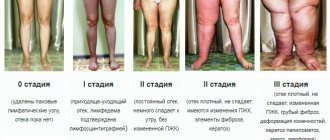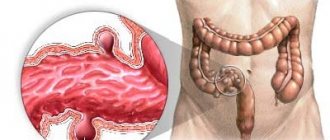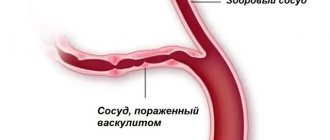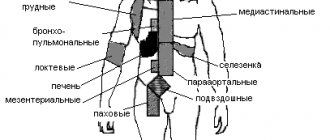Ankylosing spondylitis is a chronic joint disease that occurs systemically primarily in the spinal region. Manifests itself in the form of limited mobility of the affected area. Most often, ankylosing spondylitis occurs in men aged 15-30 years. Women are approximately 7-9 times less likely to get the disease. The disease was first considered by Russian academician V.M. Bekhterev and was named after the researcher.
Description of ankylosing spondylitis
The disease is chronic in nature, manifesting itself systemically in the body. Belongs to the group of seronegative polyarthritis. The mechanics consist of active damage to the joints of the spine, large and rarely small joints of the extremities. There is damage to the connection of the sacrum with the iliac bone of the pelvis. As a result, the patient is completely immobilized. Ankylosing spondylitis ICD 10 affects not only the osteoarticular system, but can develop in internal organs: kidneys, heart, iris. The combination of lesions is different.
Bekhterev's joint disease has the following features:
- Moderate and moderate pain is observed in the area of the femur, lower back, and back. Occurs in the morning and evening;
- Due to daily physical activity, back discomfort is somewhat reduced;
- The first sign that ankylosing spondylitis in men affects the joints appears between the ages of 15 and 30;
- As the pathology develops, an increase in pain is observed;
- In approximately 10% of cases, the disease manifests itself at an early age. Children suffer from damage to the knees, hip joints, and big toes. As you get older, your spine becomes affected.
Ankylosing spondylitis code according to ICD 10 manifests itself differently in men and women. In the stronger sex it manifests itself brightly, with a sharp aggravation of pain. Calm periods are short. Small joints are predominantly affected. The period of manifestation before the first signs of pathology lasts from 4 to 5 years. Men are susceptible to damage to all parts of the spine, which leads to curvature and limited mobility. Accompanied by damage to the vascular system and internal organs.
Ankylosing spondylitis develops in women after 40 with mild symptoms and rare acute pain. Long periods of calm occur. The time until the first symptoms appear lasts from 10 to 20 years. Mainly the spine and large joints are affected. Pain and pathology are localized in the sacral and lumbar regions. Damage to internal organs and blood vessels is rare.
Often ankylosing spondylitis ICD indicates the development of concomitant diseases, which include:
- Acute purulent arthritis;
- Inflammation of the bone - osteomyelitis;
- Sepsis;
- Limitation of foot mobility;
- Pathological dislocation.
Most patients testify that ankylosing spondylitis in women and men manifests itself in the form of pain for a period of at least three months. Inflammatory processes manifest themselves in various combinations, up to damage to the iris of the eyes.
Expert opinion
Author:
Andrey Igorevich Volkov
Neurologist, Candidate of Medical Sciences
Difficulties in diagnosing ankylosing spondylitis are associated with the similarity of the pathology in the early stages with other degenerative lesions of the musculoskeletal system. According to world statistics, ankylosing spondylitis is detected in 0.5-2% of the population. The ratio of sick men to women is 9:1. In the structure of disability, ankylosing spondylitis occupies a leading position. Without correct treatment, the pathology leads to persistent impairment of self-care and loss of ability to work.
The Yusupov Hospital uses the latest CT and MRI equipment to diagnose ankylosing spondylitis. In a modern laboratory, blood parameters are determined, changes in which indicate the possible development of ankylosing spondylitis. All necessary tests are prescribed by experienced neurologists. Treatment is selected for each patient, taking into account the characteristics of the disease. The task of doctors is not only to stop the exacerbation of symptoms, but also to select preventive therapy. At the moment, it is impossible to completely get rid of the disease. Doctors have the power to achieve stable remission and prevent the condition from worsening. In the conditions of the Yusupov Hospital, it is possible to carry out innovative therapy using stem cells.
Possible complications
Ankylosing spondylitis is dangerous due to damage to internal organs, in particular:
- heart muscle (partial or complete blockade, valve defects, inflammation of the aorta);
- eye (inflammation of the iris and ciliary body - iritis and iridocyclitis);
- lungs (fibrosis);
- kidneys (amyloidosis, uremia, renal failure).
Men are more susceptible to the development of complications, especially those who neglect medical care and refuse to look for and influence the causes of their own condition.
Causes and mechanisms of occurrence of ankylosing spondylitis
The reasons why the disease progresses are not precisely determined. Most scientists assume the influence of immune cells in relation to joint tissues and ligaments. Additionally, development is associated with genetic predisposition. People suffering from ankylosing spondylitis are carriers of the HLA-B27 antigen. It is this gene that causes pathology in the functioning of immune cells.
Ankylosing spondylitis, the causes of which affect the immune system, can be caused by systematic hypothermia and acute or chronic infectious disease. Factors such as fractures of the pelvis, spine, and frequent sports injuries contribute to the development of pathology.
Immune cells attack not only the spine; large joints and limbs are also affected. The disease affects the functioning of the heart, lungs, kidneys and genitourinary system. Thus, ankylosing spondylitis has the following causes of development:
- Heredity. The disease affects 2-3 family members;
- Infectious diseases. The risk factor has not been fully established; However, there has been a connection between joint damage and the functioning of internal organs;
- Immune disorders. Increased levels of immunoglobulins and immune complexes.
The mechanism of development is the formation of an inflammatory process in the tissues of the joint. The intervertebral discs and ligaments are gradually affected. Gradually, the connective tissue elastic structures are destroyed and overgrown with bone tissue. As a result, the spine completely loses mobility. A similar situation occurs with large and small joints.
New drugs for therapy
Today, in the practice of modern rheumatology, immunosuppressive drugs are increasingly prescribed for AS. There is a wide range of drugs that suppress the immune system. These drugs are used in the treatment of inflammatory conditions, autoimmune diseases, and after organ transplantation to prevent transplant rejection.
Are there any prospects that modern methods already exist? If we talk specifically about the invention of new methods in the treatment of ankylosing spondylitis, then there are none yet. However, a cytostatic drug called Methotrexate is used. Its action is aimed at reducing the functional abilities of the immune system, which helps slow down the progression of the pathology.
Many patients are afraid of the fact that they will have to use oncological drugs. It is immediately worth noting that in this case the dosage will be significantly less than for a malignant tumor, so they will not have an extremely negative effect on the body.
What other news in the treatment of AS is there today? It is worth noting the drug Sufasalazine, which relatively recently began to be used in the treatment of rheumatic disorders. It is used for the same purpose as described above - to control the immune system and suppress the pathological process.
The discovery was made of biological drugs, which, according to experts, are much safer for humans and act directly on the source of inflammation. They can be used for quite a long time, but there will be no severe negative impact on tissues, organs and systems.
Forms of ankylosing spondylitis
Depending on the form of development, certain organs are affected. The following are distinguished:
- Central. With this form, damage to the spine is observed. Manifests itself in one of the following variants: kyphosis, accompanied by kyphosis of the chest and hyperlordosis in the cervical region; as well as rigid, where the pathology is localized in the lumbar and thoracic regions, which leads to complete straightness of the back;
- Rhizomelic. Changes are observed in the shoulder and hip root joints;
- Peripheral. Damage to the spine occurs along with inflammation of peripheral joints, for example, the elbow or knee;
- Scandinavian. The course of the disease resembles the initial stage of rheumatoid arthritis. Leads to damage to small joints.
Additionally, the visceral form is distinguished. Characterized by damage to the spine and joints. This form is accompanied by disruption of the functioning of internal organs.
Nonsteroidal anti-inflammatory drugs (NSAIDs)
They are divided into non-selective (inhibiting cyclooxygenase-1 and cyclooxygenase-2) and non-selective (inhibiting only COX-2). Patients are prescribed drugs from both groups.
Selective NSAIDs:
- The very first and most popular drug to appear on the pharmacological market is nimesulide (Nimesil, Nise). The maximum dose for an adult is 400 mg per day, in several doses. Just like other NSAIDs, it has side effects. The main side effect is an increased risk of liver damage (especially if the patient already had problems with it). There may also be headaches, nausea, vomiting, and ulcerations of the mucous membrane of the stomach and intestines. But the benefits of using the drug are much higher than the possible risks.
- In addition to nimesulide, the patient may be prescribed Celebrex or meloxicam.
Non-selective NSAIDs:
- Diclofenac. Gold standard in rheumatology. Effective in the treatment of most rheumatic diseases. Usually prescribed in tablets of 50 mg 3 times a day. The dose may vary according to the needs of the patient. Unfortunately, due to its non-selectivity, diclofenac has several unpleasant side effects: irritation of the mucous membrane of the gastrointestinal tract (up to the formation of ulcers and erosions in the stomach and duodenum), liver damage, nausea and vomiting, inhibition of hematopoietic processes. If for gastric manifestations the patient can be prescribed omez 30 mg 2 times a day, and for nausea cerucal, then there are no special measures for liver damage and inhibition of hematopoietic processes.
- Sometimes, instead of diclofenac, patients are prescribed ketoprofen, ibuprofen, and indomethacin. But the side effects of all non-selective drugs are the same.
Symptoms of ankylosing spondylitis in women and men
At the initial stage, ankylosing spondylitis has no symptoms or they are subtle. However, signs of development may be different. In approximately 70% of cases, patients complain of pain in the lumbar region. In 20% of pain occurs in peripheral joints. And only 5% of patients experience eye damage in the form of iritis or iridocyclitis.
However, after a number of studies, it was possible to prove that the first signs appear in periodic pain localized in small and large peripheral joints. Approximately more than 60% of patients suffer from an unstable form of arthritis. Ankylosing spondylitis symptoms in men occur more often in the form of acute pain in the lumbosacral region, which radiates to the gluteal muscles or heart, depending on the form of the disease.
Thus, the primary localization appears in the area of the peripheral joints. However, the likelihood of this manifestation is insignificant. Rarely, ankylosing spondylitis is indicated by pain in the cervical spine, which appears mainly in the morning. During the day, the stiffness of the section disappears due to mobility. Inflammatory processes in the heels occur less frequently, particularly in the area of the Achilles tendon.
Often during the disease there is a dull, lingering pain that is localized in the lumbosacral region. The first signs of pathology are identified in the form of crises, which then continue for several days and sometimes months. This pain intensifies at night.
The characteristics of the first symptoms are variable, which complicates diagnosis and treatment. On average, there are several variants of signs of pathology. These include:
- When the sacral area becomes inflamed, pain and accompanying inflammation are observed. Discomfort gradually increases, accompanied by joint damage;
- In adolescence, ankylosing spondylitis manifests itself in the form of monooligoarthritis, which is unstable and asymmetrical in nature. As inflammation develops, symptoms of sacroiliitis develop;
- In childhood and adolescence, the onset of the disease occurs in the form of polyarthritis. The pain is of a flying type, slight swelling of the affected area is possible. Small and large peripheral joints are subject to inflammation. There is an increase in body temperature and increased heart rate.
In rare cases, it is characterized by an acute form of fever in a stable form. During the day, sweating, fever, and chills occur. The patient loses weight, trophic disorders develop. At the same time, polymyalgia and polyarthralgia develop. After a few weeks, a type of arthritis occurs.
Extra-articular localization is accompanied by eye damage. Iritis or iridocyclitis develops. In rare cases, carditis and aortitis may occur, which increases inflammation. After several months of development of concomitant diseases, sacroiliitis appears.
Examination of the early stage of development of ankylosing spondylitis is almost impossible to correctly diagnose. It can be determined only by the patient’s characteristic complaints: weak mobility of the spine in the morning, which disappears during the day. During the examination, the patient indicates stiffness of the vertebrae, there is a slight manifestation of dorsal kyphosis, and difficulty performing the respiratory function.
Ankylosing spondylitis in women, symptoms and concomitant diseases, proceeds slowly. Men experience progression three to four times faster. Lack of timely treatment leads to complete loss of joint mobility. Clinical manifestations depend directly on the site of development. Most often, damage occurs from the bottom up.
The main symptoms include the following:
- A sharp increase in fatigue;
- Limitation of vertebral mobility;
- Disturbance in sleep and wakefulness due to pain;
- Discomfort in the back and joints;
- Difficulty breathing due to damage to the sternoclavicular joints;
- Development of arthritis;
- Rachiocampsis;
- Loss of mobility.
Ankylosing spondylitis in women, symptoms and treatment accordingly, manifests itself as a protracted illness, often occurring in the lumbosacral region. The pain occurs at night and intensifies in the morning. They can be described as inflammatory processes.
Symptoms vary according to the stage of the disease. During the first stage, the following pathologies are distinguished:
- Stiffness of movement, which manifests itself in the morning and after a long stay in one position. Occurs during gymnastics;
- Discomfort in the area of the sacrum and hip joint;
- Pain in the chest. Especially when coughing and taking a deep breath;
- Feeling of lack of air;
- Fatigue and irritability.
In later stages, the disease is characterized by the following symptoms:
- Signs indicating radiculitis are observed. There is unbearable pain in the spine, numbness of the limbs;
- Deterioration of blood supply to the brain;
- Feeling of suffocation due to decreased movement of the chest. This results in dysfunction of internal organs;
- Increased blood pressure;
- There is a change in the shape of the spine, its mobility is lost.
Organization of a sleeping place
The patient must properly organize his sleeping place. You should choose a flat and firm mattress. At the initial stages of the disease, the pillow should be abandoned. This will avoid the development of cervical lordosis. It is best to sleep on your stomach. As the disease progresses, you can place a cushion or thin pillow under your head. Legs should be kept straight.
Diagnostics
Diagnosis and treatment are carried out under the supervision of the following specialists:
- Therapist;
- Vertebrologist - a doctor who deals with diseases of the vertebrae;
- Orthopedist;
- Rheumatologist.
Ankylosing spondylitis, the diagnosis of which involves a number of tests, is determined as a result of a preliminary examination, study of the medical history and the results of the study. Patients are prescribed the following measures:
- Patients are prescribed an X-ray examination of the spine, CT and MRI;
- A general blood test is taken to determine ESR levels;
- Carrying out, if necessary, tests to determine the HLA-B27 antigen.
Additionally, a consultation with an orthopedist or neurologist is carried out. The disease must be differentiated from degenerative spinal problems. These include spondylosis and osteochondrosis. If ankylosing spondylitis develops at an early age, then DZP manifests itself from the age of 30. The Scandinavian form of the disease must be distinguished from rheumatoid arthritis, which usually manifests itself in women.
Treatment of ankylosing spondylitis
Therapy for ankylosing spondylitis involves an integrated approach. Treatment is lengthy and requires responsibility. Is it possible to cure ankylosing spondylitis? It is impossible to completely get rid of the disorder in the body. All measures are aimed at eliminating pain and reducing inflammation. Drug therapy involves:
- The use of non-steroidal anti-inflammatory drugs such as Diclofenac, Indomethacin;
- Glucocorticoids such as Prednisolone;
- Immunosuppressants - Methotrexate, Leflunomide and others. Immunosuppressants are used to prevent tumor necrosis. Prescribed in cases where basic therapy has not produced results;
- Drugs to normalize the functioning of the immune system: TNF-a inhibitors, inhibitor of B-cell activation.
The patient will have to perform a number of measures, the purpose of which is to prevent the process of ankylosis of the joints and spine, namely:
- During the period of pain subsiding, therapeutic exercise therapy is carried out for ankylosing spondylitis. It is recommended to go skiing and practice in the pool;
- If possible, carrying out balneological procedures;
- It is necessary to attend phonophoresis with hormonal drugs, as well as paraffin therapy, ultrasound treatment;
- It is important to regularly monitor your posture during treatment and rehabilitation;
- Sleep only on a flat, hard surface;
- The patient is prohibited from static loads on the spinal column, as well as any physical activity or exercise. Especially lifting weights.
The administration of corticosteroid hormones into the joint cavity is prescribed. Liquid nitrogen cryotherapy is performed on the spinal column. It is used to suppress pain and alleviate the patient's condition. Auxiliary procedures include back massage and hirudotherapy. However, they are allowed only in the remission stage. Treatment of ankylosing spondylitis with drugs aimed at relieving symptoms is selected individually.
A positive effect is observed from paraffin therapy and trips to the bathhouse. However, a hot bath or shower aggravates the disease. Most methods are selected on an individual basis in accordance with the nature of the disease and tolerability.
Diet preparation
Doctors recommend sticking to a protein diet. You should exclude flour products from the menu, refuse potatoes, pasta and any fatty foods. Nutrition for ankylosing spondylitis includes foods such as red grouse, eggs, cottage cheese, boiled meat, and vegetables.
Patients who frequently drink alcohol, sweet carbonated drinks, chips, etc. completely eliminate their use. This applies to smoking and drug use.
Exercise therapy and massage
Gymnastics for ankylosing spondylitis is a mandatory procedure in complex treatment. It is important that all exercises are vigorous and work the joints in amplitude. Turns, tilts and rotations are required. The joints should be used as much as possible. So, if you do it regularly for 30 minutes, you will see a positive effect.
Water aerobics has a quick positive effect. As an alternative, training in a dry pool using the Ugul apparatus is suitable. Massage is allowed to be used only in the remission stage. So the impact on the joints will not be too intense.
Organization of a sleeping place
The correct sleeping place will prevent the progression of the disease. Ankylosing spondylitis during the period of treatment and remission should completely abandon the pillow. Such measures will prevent the development of cervical lordosis. It is recommended to sleep on your stomach. As ankylosing spondylitis is eliminated by treatment, it is permissible to place a cushion under the head. Legs are kept straight.
Features of taking NSAIDs
The newest medications for ankylosing spondylitis are nonsteroidal anti-inflammatory drugs. Appointed for a year or more. The maximum course of treatment is five years. During the acute period, the maximum dosage is prescribed. As a positive effect is obtained, the amount of the drug decreases. Medicines are prescribed on an individual basis. In the absence of remission, a complete review of the diagnosis is carried out.
Other therapies
Medicine does not stand still. New treatment methods are regularly introduced. Ankylosing spondylitis, clinical recommendations have shown, can be overcome with the following alternative techniques:
- Reducing inflammation in joints with Sulfasalazine. However, the therapeutic result is not noticed immediately, but only after 2-6 months;
- Muscle tension is reduced with Tolperisone or Mydocalm;
- Severe inflammatory processes are relieved by glucocorticoids. It is prescribed only in advanced forms, as it has a high risk of developing complications of the digestive system. high risk of diabetes, osteoporosis. I received positive reviews of sulfasalazine for ankylosing spondylitis. The result is noticeable after a month of use;
- In the final stages, cytostatics and corticosteroids are prescribed.
Innovative therapies
In modern medicine, ankylosing spondylitis is treated according to the latest news and discoveries. Stem cell therapy is a new technique with positive effects. It is prescribed in the early stages of the disease, before the final deformation of the spinal column and large joints occurs. How to treat ankylosing spondylitis with stem cells?
Stem cells stop further progression of the disease and stop the spread of bone tissue. At the same time, pain gradually disappears and motor function improves. The patient indicates an improvement in his condition. When additional exercise therapy is used, remission occurs faster.
Is ankylosing spondylitis treated using innovative methods? It is impossible to completely get rid of the pathology. However, achieving remission and slowing down the progression is quite possible. The main thing is to regularly conduct examinations and exercises for ankylosing spondylitis.
Application of physiotherapy
It is carried out in accordance with the stage of disease progression. With active development, ultraviolet irradiation of the affected area is prescribed. It has an analgesic and anti-inflammatory effect. The course of therapy consists of 10-12 procedures.
Physiotherapy for ankylosing spondylitis of moderate and low progression activity is widely used. Ultrasound, decimeter therapy, microwaves, inductothermy, ultraphonophoresis and other procedures are prescribed in accordance with the nature of the disease. in rare cases, balneotherapy is used.
Pathogenesis
Ankylosing spondylitis mainly affects cartilaginous joints. Articular cartilage due to autoimmune effects is subject to inflammation and destruction. In this case, there is no infection in the joint cavity, unlike septic infectious arthritis.
Destructively altered articular surfaces lose their congruence (anatomical correspondence to each other), which is manifested by pain and motor limitations. Subsequently, the pathology spreads to the (subchondral) bone located under the cartilage, to nearby muscles and ligaments.
All these structures are also subject to destruction, and connective tissue grows in their place. This tissue tightly and motionlessly fixes the elements that form the joint. Subsequently, these articular elements grow together. This is how ankylosis develops.
Prognosis and prevention
On average, it takes 5-7 years from the appearance of the first symptoms to the correct diagnosis. Patients require consultation with a rheumatologist and immunotherapy. Ankylosing spondylitis has a favorable prognosis for the patient's life. New treatment methods make it possible to stop the destruction of joints in the body. The main problem is timely correct diagnosis.
Patients are recommended to regularly undergo physical therapy and immunotherapy. Otherwise, complications will progress sharply in the form of severe pain and immobility, as well as disruption of the functioning of internal organs. The development of fibrosis, nephropathy, and failure of the kidneys and intestines is observed. In the absence of treatment, disability is prescribed for ankylosing spondylitis.
Methods for primary prevention of the disease have not yet been discovered.
conclusions
It is impossible to completely cure ankylosing spondylitis. A person with such a diagnosis will have to be constantly monitored by a specialist, and during periods of exacerbation should be hospitalized in a traumatology or rheumatology department.
Rehabilitation is the most important part of therapy. It is necessary to regularly perform special exercises selected by qualified specialists in the field of rehabilitation, as well as use such accessible physical therapy products as the Lyapko applicator at home.
Ankylosing spondylitis, when treated properly, usually has a good prognosis with milder symptoms and significantly slower progression.
The use of Lyapko application devices is an excellent preventive measure and the key to your health, vitality and good mood!
Treatment of ankylosing spondylitis in Moscow
Treatment of ankylosing spondylitis in Moscow is available at the Yusupov Hospital medical institution, you can get detailed advice on the characteristics of pain in the lower back, shoulder girdle and in any other department. Using the latest equipment, doctors make an accurate diagnosis and conduct a detailed examination of the body. As a result, a detailed picture of the therapy method and the nature of the rehabilitation is formed.
The work of doctors is based on the experience of Slavic and foreign doctors and scientists in this field. During treatment, patients are provided with a comfortable hospital, intensive care, and a diagnostic center. You can make an appointment or ask questions by phone.
Prescription of selective immunosuppressants
Drugs that stop the work of tumor necrosis factors are increasingly used to treat ankylosing spondylitis.
Selective immunosuppressants are prescribed only when basic therapy does not produce the desired effect. These drugs are quite expensive, and their use increases the risk of developing tuberculosis, sepsis and other severe infections due to suppressed immunity.
These medications include Etanercept (Enbrel), Adalimumab (Humira), and Infliximab (Remicade).






